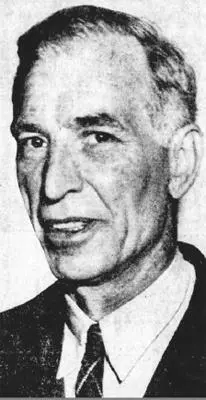“I’ll take better care of her than you did,” Cohen replied.
The train trip took two nights and two days. La Salle, Detective Thompson, and Detective Dube left San Francisco at 5:00 P.M. Pacific time on the City of San Francisco . Overnight the train passed through Sacramento, Salt Lake City, Cheyenne, Omaha, and Council Bluffs and reached Chicago early Saturday morning, where the trio changed trains to the New York–bound General . Thompson had no relief or privacy, shackled to the man he’d been chasing for nearly two years. Just as La Salle could not escape the law, so could the law not escape La Salle.
The General pulled into North Philadelphia Station at six minutes before seven in the morning on April 1. To the surprise of waiting reporters and photographers, the trio of men were not on board. To avoid the scrum, they’d gotten off at an earlier stop in Paoli, met there at 6:30 A.M. by Assistant Prosecutor William Cahill and Camden County Police Captain James Mulligan.
They took La Salle directly to the prosecutor’s office. Then Thompson went home, no doubt relieved to be free of the man. Dube, Mulligan, and Cahill stuck around for Cohen’s interrogation of La Salle, which lasted about four hours. At 1:00 P.M., La Salle was taken to the Camden County jail.
Mitchell Cohen told the press later on Sunday that he expected the case to go before the jury no earlier than June. Early on the morning of April 3, 1950, the day La Salle was due to be arraigned on the abduction and kidnapping charges, Cohen received a phone call from the county jail. The accused wanted to talk.
Cohen arrived at the jail at 9:45 A.M. and discovered La Salle by himself in a waiting room. He still lacked a lawyer—he hadn’t been able to keep on Manuel Gomez because Gomez was not licensed to practice outside of California.
Cohen reminded La Salle of his right to an attorney. If he couldn’t afford one, the court would appoint a lawyer for him.
“I don’t need any counsel,” La Salle replied. “I am guilty, and I am willing to go in and plead guilty. The sooner the better. I want to get it off my chest, and I want my time to commence to run.”
When Cohen asked him why he wanted to plead guilty, La Salle said, “I want to avoid this girl [receiving] any further unfavorable publicity.”
Cohen told him that court was already in session, and he could immediately enter his plea.
“Then I want to get it over with now,” said La Salle.
Cohen left the Camden County jail and went straight to the courthouse for the arraignment. The courtroom was packed with onlookers. Sally Horner took her seat at the back next to a detective assigned to guard her. She wore a blue suit, pink blouse, straw hat, and patent leather Mary Jane shoes.
At ten minutes to noon, La Salle filed in, wearing a navy-blue suit, white collared shirt, and tie.
As Judge Rocco Palese entered, the room rose to attention. Like Mitchell Cohen, the judge had tangled with La Salle before. Palese, then a lawyer, had worked on Dorothy Dare’s divorce petition against La Salle in 1944, even filling in for Dorothy’s main lawyer, Bruce Wallace, at one of the hearings while La Salle was still serving time for statutory rape.
Palese, to the best of anyone’s knowledge, never disclosed this prior association with the defendant. Perhaps he did not remember. Perhaps he didn’t see a conflict because he had never engaged La Salle directly in court. Camden County’s legal world was so small that defense attorneys became prosecutors who then became judges, everyone working with everyone else. What mattered was that, right now, Frank La Salle was in Judge Palese’s courtroom.
When the gallery took their seats again, Palese called on Cohen to begin.
The prosecutor first outlined the story of Sally’s kidnapping and confinement. How La Salle “persuaded and enticed her” to leave her mother in mid-June 1948, and told her that his repeated rapes of her were “natural.” How Ruth Janisch “broke La Salle’s spell” in San Jose, and Sally made the fateful phone call to the Panaros. How La Salle’s long criminal record and his deviant behavior toward Sally made him, in Cohen’s estimation, “a menace to society—a depraved man and a moral leper.”
Cohen addressed both the judge and the crowd with his final words: “Mothers throughout the country will give a sigh of relief to know that a man of this type is safely in prison. That La Salle is somewhere safe, unable to harm anyone else.”
Judge Palese asked Cohen if he had anything further. He did.
“If the Court please, at this time I propose to take pleas from this defendant, Frank La Salle, but before doing so I want the Court to know that I have discussed this case quite at length with this defendant, I have advised him of his right to be represented by counsel, and to have the benefit of the advice of counsel. I have warned him of the seriousness of these charges, and the length of the sentences which these charges impose.
“Being in Court is not an unfamiliar subject to this defendant and he understands, and he has told me so, the contents of both indictments. He understands the seriousness of them and the sentences, the minimum sentences, which the Court can impose, and he has advised me he does not desire to obtain counsel either on his own or appointed by the Court. I do, however, feel, in order that this defendant may properly understand the situation that it may be best for the Court to repeat to him his rights before I take the pleas.”
Judge Palese then addressed Frank La Salle. “Mr. La Salle, you have just heard the prosecutor advise the Court that he has talked to you and explained to you the two indictments that have been returned against you by the Grand Jury of our County, and he has indicated to the Court that you do not desire to be represented by counsel and you desire to proceed in the matter without representation, is that correct?”
La Salle replied, “Yes.”
“You understand the seriousness of the two indictments that have been returned against you by our Grand Jury?” Palese asked.
“Yes, sir.”
“And that they carry with them rather serious sentences?”
Again, La Salle replied, “Yes, sir.”
Judge Palese asked how La Salle would plead.
“Guilty,” he said, in a voice barely audible.
The judge asked if there was anything more La Salle wished to say before he handed down the sentence.
La Salle said, his voice still weak: “I don’t want any more publicity for the children.” (Cohen later explained to reporters that La Salle was likely nervous and meant to say “child.”)
Just like that, the proceeding was over. The whole matter took perhaps twenty minutes, ending just after noon. But not before Palese decided upon a sentence for Frank La Salle. The judge ordered Sally’s abductor to spend no less than thirty and no more than thirty-five years in prison for the kidnapping charge. He would have to serve at least three-quarters of the full sentence before being eligible for parole. Palese also added a two-to three-year sentence for the original abduction charge, as well as an additional two to three years for violating his parole.

Frank La Salle, after pleading guilty.
Two days later, just after noon on April 5, La Salle began his sentence at Trenton State Prison.
BECAUSE FRANK LA SALLE pleaded guilty, Sally did not get to testify against him. In Mitchell Cohen’s office after the hearing, she asked, once more, letting go of the earlier courtroom stoicism and blinking back tears, when she could go home. With the case finished, and Frank La Salle going to prison, surely she could return to her mother right away?
Читать дальше













